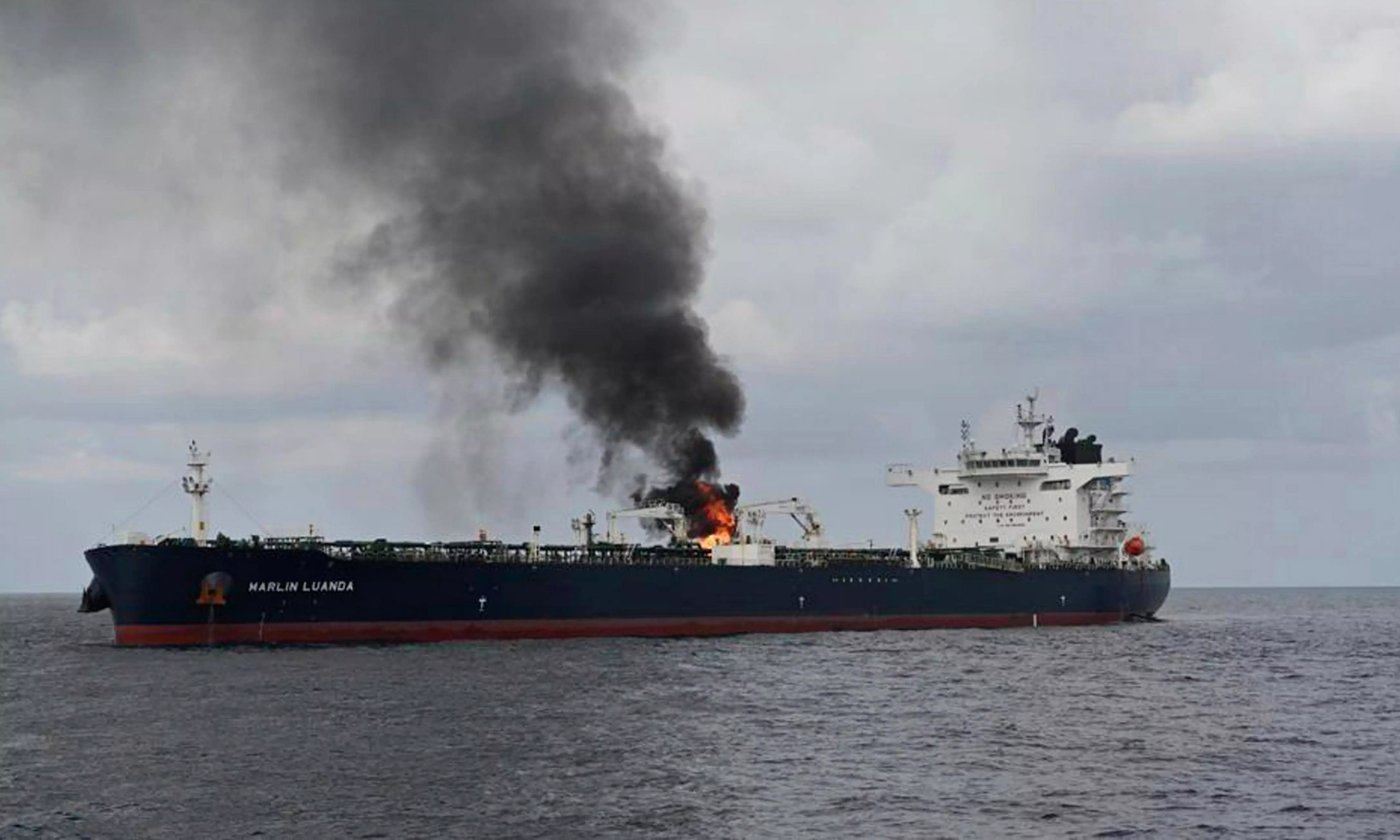
An oil tanker on fire after an attack by Houthi rebels while passing through the Red Sea | PTI-AP Photo
India’s 50% exports, 30% imports pass through Red Sea route: Crisil

Mumbai, Jan 28 (PTI) The impact of the ongoing crisis around the Red Sea shipping route, which accounts for 50 per cent of the country's exports and 30 per cent of imports last fiscal, will vary depending on the industry, according to a report.
The crisis in the Red Sea shipping route began after Yemen-based Houthi rebels launched frequent attacks on commercial shipping vessels plying through the route in November as a fallout of the Israeli-Palestinian war, which started in early October 2023. Currently, the US and British forces are also engaged in counter-attacks on the militants.
Domestic companies use the Red Sea route through the Suez Canal to trade with Europe, North America, North Africa and part of the Middle East. Last fiscal, these regions accounted for 50 per cent of the country's exports worth Rs 18 lakh crore and 30 per cent of imports worth Rs 17 lakh crore.
The country's overall merchandise trade was Rs 94 lakh crore last fiscal, with 68 per cent in value and 95 per cent in volume being sea-borne, according to a report by Crisil Ratings.
The country imports 30 per cent of DAP from Saudi Arabia, 60 per cent of rock phosphate from Jordan and Egypt, and 30 per cent of phosphoric acid from Jordan.
Companies operating in sectors like agricultural commodities and marine foods could see a significant impact due to the perishable nature of their goods and/or lean margins, which limit their ability to absorb the risks from rising freight costs.
The Shanghai Northern Europe container freight rates have risen by over 300 per cent to USD 6,000-7,000/TEU) since November 2023.
On the other hand, companies operating in sectors like textiles, chemicals and capital goods may not be immediately hit, as they have a better ability to pass on higher costs, or because of a weaker trade cycle. But a prolonged crisis can make these sectors also vulnerable as working capital cycles would get stretched with orders put on hold.
However, a few sectors, such as shipping, could benefit from rising freight rates. Lastly, players in pharma, metals, and fertilisers will not be much impacted.
Increasing attacks on ships sailing in the Red Sea region since November 2023 have persuaded shippers to consider the alternative longer route past the Cape of Good Hope. This has not only stretched delivery time by 15-20 days but has also increased the transit cost substantially because of incremental freight rates and insurance premiums.
For agricultural commodities like Basmati rice (30-35 per cent of production is shipped to these regions), exporters are feeling the pressure as rising freight costs have curbed exports and a part of their inventory is now being sold in the domestic market, leading to a moderation in realisations.
Similarly, marine items (predominantly shrimps and prawns) can also see a significant impact as 80-90 per cent of the production is exported, and over half of it is through the Red Sea. Their perishable nature and lean margins make exporters vulnerable to rising freight costs and competitive pressure from Latin American suppliers.
While textiles, especially home textiles (75 per cent of the production is exported, mainly to these regions), their mid-teen margins can absorb higher freight rates for some time. Similarly, in chemicals (25-30 per cent of the revenue of agrochemicals and speciality chemicals makers comes from these regions), exports may be less affected given sufficient channel inventories and a subdued near-term demand scenario.
Players in the capital goods sector (with exports and imports of over Rs 2 lakh crore each) can be impacted by a sustained disruption in trade routes due to delays in deliveries, which can lead to inventory build-up and slowdown in order conversions for EPC companies.
For certain import-dependent players, such as non-urea fertiliser makers, which source end-product and/or its key raw materials/intermediates, the impact will be limited given the current lean consumption period and sufficient inventories, but a sustained increase in sourcing cost will have to be compensated through a higher subsidy from the government.
Crude oil may also be less impacted as only 10 per cent of the global oil trade is through the Red Sea, and the current disruptions have had a limited impact on prices. Crude prices rose 5-7 per cent to USD 80/barrel in mid-December 2023, following an escalation of the crisis but prices have since settled in the USD 77-80/barrel range.
It is not that the impact of the Red Sea crisis will be negative for all sectors. In fact, for some sectors, it will offer tailwinds. Shipping companies and freight forwarders should benefit from higher charter rates, after a year that saw steep falls due to slowing global trade.
While the immediate impact of the crisis would be low for most of India Inc., prolonged strife can affect the profitability and working capital cycle of export-oriented industries. The extent of this will vary depending on sectoral nuances. Supply chain issues could also intensify, curbing trade volume and renewing inflationary pressures. PTI

